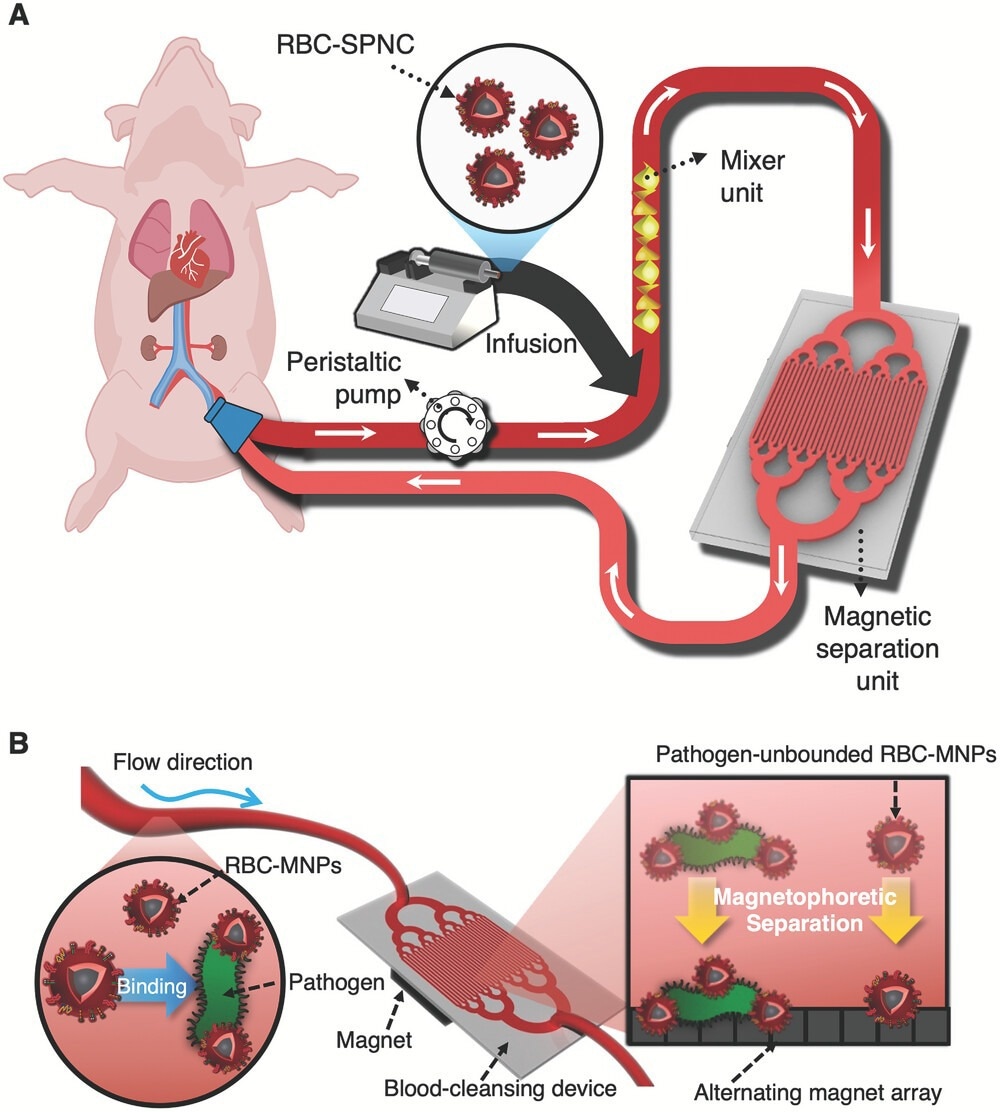Reviewed by Lexie CornerMay 28 2024
Researchers from the Seoul National University Bundang Hospital and UNIST have developed a novel technology that eliminates agents that cause inflammation from extracorporeal blood. Professors Joo Hun Kang, Jinmyoung Joo, and Jae Hyuk Lee led this research, which was published in the journal Small Methods. These findings are expected to transform the treatment of sepsis.
 Schematic image showing the magnetic extracorporeal blood cleansing system utilizes superparamagnetic nanoclusters (SPNCs) enveloped by nanovesicles derived from red blood cells (RBC-SPNCs). Image Credit: Ulsan National Institute of Science & Technology
Schematic image showing the magnetic extracorporeal blood cleansing system utilizes superparamagnetic nanoclusters (SPNCs) enveloped by nanovesicles derived from red blood cells (RBC-SPNCs). Image Credit: Ulsan National Institute of Science & Technology
The researchers used Magnetic Nanoparticles (MNPs) encased in red blood cell-derived nanovesicles (RBC-MNVs) to present a clinically practical magnetic extracorporeal blood cleansing device.
The novel approach uses Superparamagnetic Nanoclusters (SPNCs) to quickly and efficiently eliminate pathogenic and pathogen-related chemicals that induce sepsis. Preclinical investigations conducted on lethally infected bacteremic model swine with similar physiological characteristics proved the clinical efficacy of their SPNC-based blood cleansing approach.
Our study highlights the significant reduction in pathogenic agents in both the blood and major organs, as well as amelioration of hemodynamic and hematological parameters, followed by the preservation and restoration of major organ functions. Furthermore, it was possible to effectively remove a broad range of pathogens and inflammatory agents in the blood and major organs without prior diagnosis, leading to a breakthrough treatment effect.
Joo Hun Kang, Professor, Department of Biomedical Engineering, Ulsan National Institute of Science and Technology
Sepsis is a systemic abnormal inflammatory response to infection that causes the immune system to attack tissues, resulting in inflammation and organ damage. Sepsis has no proven pharmaceutical therapeutic options.
Using scavenger MNPs encapsulated by blood cell-derived nanovesicles (MNVs), Professor Kang and his research team produced a comparable technique in a previous study completed in 2022.
MNVs magnetically destroy a wide range of pathogens in an extracorporeal circuit. However, due to a poor magnetization rate, the technique presented in earlier research exhibited technical constraints, making the purification of several liters of extracorporeal blood difficult.
To address this, the researchers in the current study conducted theoretical calculations to calculate the size and dispersion of MNPs required to clean adult patients' blood in less than an hour. By creating a novel hydrothermal synthesis technique, scientists produced SPNCs with enhanced magnetization rate and particle uniformity.
Using lethally infected bacteremic model swine, they further verified the therapeutic efficacy of their SPNC-based blood cleansing approach. Additionally, in a swine sepsis model, their extracorporeal device rapidly collected and magnetically separated a broad spectrum of pathogens at high blood flow rates (>6 L h−1).
“Our findings demonstrate that the RBC-SPNC-based blood cleansing method improved hemodynamics, attenuated the inflammatory cytokine response, maintained organ function, and increased survival rates. We, thus, believe that this treatment could be beneficial regardless of the antibiotics initially used for sepsis treatment,” noted the research team.
Professor Kang outlined their plans to validate and introduce medical devices that will faciliate the use of this technology in healthcare.
We aim to develop novel approaches for the treatment of infectious diseases to combat new and mutated pathogens without the need for prior diagnosis as part of a health security strategy. Our findings suggest the possible use of RBC-SPNCs for extracorporeal therapy of severe sepsis in large animals and potentially in humans.
Joo Hun Kang, Professor, Department of Biomedical Engineering, Ulsan National Institute of Science and Technology
The study's first authors were Sung Jin Park and Suhyun Kim from the Department of Biomedical Engineering at UNIST, as well as Professor Inwon Park from Seoul National University Bundang Hospital.
This research was supported by the Samsung Research Funding and the Basic Research Laboratory (BRL) research grant from the National Research Foundation (NRF) of Korea and funded by the Ministry of Science and ICT (MSIT).
It was also funded, in part, by the Korea Health Technology R&D Project through the Korea Health Industry Development Institute (KHIDI) and the Korea Dementia Research Center (KDRC) funded by the Ministry of Health & Welfare and the POSCO Science Fellowship of the POSCO TJ Park Foundation.
Journal Reference:
Park, J. S., et al. (2023) Extracorporeal Blood Treatment Using Functional Magnetic Nanoclusters Mitigates Organ Dysfunction of Sepsis in Swine. Small Methods. doi.org/10.1002/smtd.202301428.